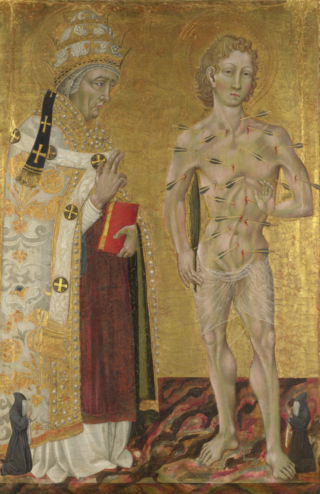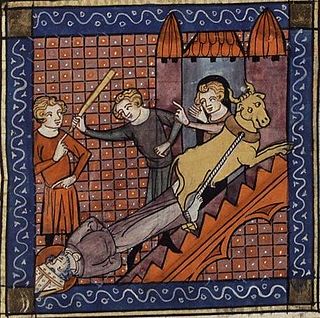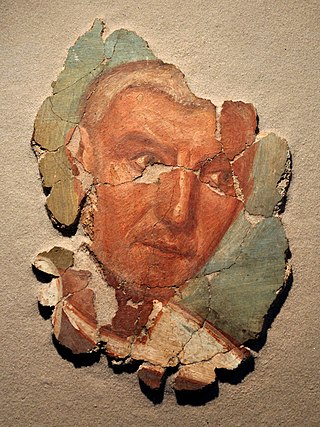Pope Zosimus was the bishop of Rome from 18 March 417 to his death on 26 December 418. He was born in Mesoraca, Calabria. Zosimus took a decided part in the protracted dispute in Gaul as to the jurisdiction of the See of Arles over that of Vienne, giving energetic decisions in favour of the former, but without settling the controversy. His fractious temper coloured all the controversies in which he took part, in Gaul, Africa and Italy, including Rome, where at his death the clergy were very much divided.

Pope Fabian was the bishop of Rome from 10 January 236 until his death on 20 January 250, succeeding Anterus. A dove is said to have descended on his head to mark him as the Holy Spirit's unexpected choice to become the next pope. He was succeeded by Cornelius.

Arles is a coastal city and commune in the South of France, a subprefecture in the Bouches-du-Rhône department of the Provence-Alpes-Côte d'Azur region, in the former province of Provence.

Denis of Paris was a 3rd-century Christian martyr and saint. According to his hagiographies, he was bishop of Paris in the third century and, together with his companions Rusticus and Eleutherius, was martyred for his faith by decapitation. Some accounts placed this during Domitian's persecution and incorrectly identified St Denis of Paris with the Areopagite who was converted by Paul the Apostle and who served as the first bishop of Athens. Assuming Denis's historicity, it is now considered more likely that he suffered under the persecution of the emperor Decius shortly after AD 250.

Martial, called "the Apostle of the Gauls" or "the Apostle of Aquitaine", was the first bishop of Limoges. His feast day is 30 June.

Gatianus in the third century AD was the founding bishop of the see of Tours. He was one of the "seven apostles of Gaul" commissioned by Pope Fabian to evangelize in the region.

Stremonius or Saint Austremonius or Saint Stramonius or Austromoine, the "apostle of Auvergne," was the first Bishop of Clermont. He is venerated as a saint in the Catholic Church.

Saturnin of Toulouse was one of the "Apostles to the Gauls" sent out during the consulate of Decius and Gratus (250–251) to Christianise Gaul after the persecutions under Emperor Decius had all but dissolved the small Christian communities. Fabian sent out seven bishops from Rome to Gaul to preach the Gospel: Gatien to Tours, Trophimus to Arles, Paul to Narbonne, Saturnin to Toulouse, Denis to Paris, Austromoine to Clermont, and Martial to Limoges. His feast day is 29 November.

The Church of St. Trophime (Trophimus) is a Roman Catholic church and former cathedral located in the city of Arles, in the Bouches-du-Rhône Department of southern France. It was built between the 12th century and the 15th century, and is in the Romanesque architectural tradition. The sculptures over the church's portal, particularly the Last Judgement, and the columns in the adjacent cloister, are considered some of the finest examples of Romanesque sculpture.
Paul of Narbonne was one of the "apostles to the Gauls". They had been sent out during the consulate of Decius and Gratus. Their mission was to Christianise Gaul after the persecutions under Emperor Decius had all but dissolved the small Christian communities. According to the hagiographies, Fabian sent out seven bishops from Rome to Gaul to preach the Gospel: Paul to Narbonne, Gatien to Tours, Trophimus to Arles, Saturnin to Toulouse, Denis to Paris, Austromoine to Clermont, and Martial to Limoges.
The Archbishopric of Vienne, named after its episcopal seat in Vienne in the Isère département of southern France, was a metropolitan Roman Catholic archdiocese. It is now part of the Archdiocese of Lyon.

The former French Catholic Archbishopric of Arles had its episcopal see in the city of Arles, in southern France.
The architecture of Provence includes a rich collection of monuments from the Roman era, Cistercian monasteries from the Romanesque period, medieval castles and fortifications, as well as numerous hilltop villages and fine churches. Provence was a very poor region after the 18th century, but in the 20th century it had an economic revival and became the site of one of the most influential buildings of the 20th century, the Unité d'Habitation of the architect Le Corbusier in Marseille.
Gaul was an important early center of Latin Christianity during late antiquity and the Merovingian period. By the middle of the 3rd century, there were several churches organized in Roman Gaul, and soon after the cessation of persecution, the bishops of the Latin world assembled at Arles in AD 314. The Church of Gaul passed through three crises in the late Roman period, Arianism, Priscillianism and Pelagianism. Under Merovingian rule, a number of "Frankish synods" were held, marking a particularly Germanic development in the Western Church. A model for the following Frankish synods was set by Clovis I, who organized the First Council of Orléans (511).
Virgilius of Arles was Archbishop of Arles in Gaul.

Gallo-Roman culture was a consequence of the Romanization of Gauls under the rule of the Roman Empire. It was characterized by the Gaulish adoption or adaptation of Roman culture, language, morals and way of life in a uniquely Gaulish context. The well-studied meld of cultures in Gaul gives historians a model against which to compare and contrast parallel developments of Romanization in other less-studied Roman provinces.

Saint Nectarius of Auvergne is venerated as a 4th-century martyr and Christian missionary.

December 28 - Eastern Orthodox liturgical calendar - December 30

Saint Trophimus' Church is a Romanesque church in Eschau, a small town in the suburbs of Strasbourg, the historical capital of Alsace. The church is dedicated to Trophimus of Arles.

The Church of the Saintes Maries de la Mer is a Romanesque fortified church built in the 9th century in Saintes-Maries-de-la-Mer in Camargue, Bouches-du-Rhône, Provence. Dedicated to Mary, mother of Jesus and to The Three Marys, it is the subject of annual Roma pilgrimage. Since 1840, it has been classified as a French Historical Monument.













